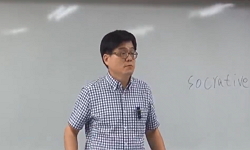학교에서 학습한 지식이 학생의 실생활과 괴리된다는 비판이 크다. 2015와 2022 개정 교육과정에서는 이해중심 교육과정과 역량기반 교육과정 이론을 내세우며 학교에서 학습한 지식의 다른 ...
http://chineseinput.net/에서 pinyin(병음)방식으로 중국어를 변환할 수 있습니다.
변환된 중국어를 복사하여 사용하시면 됩니다.
- 中文 을 입력하시려면 zhongwen을 입력하시고 space를누르시면됩니다.
- 北京 을 입력하시려면 beijing을 입력하시고 space를 누르시면 됩니다.

학교에서 학습하는 역사 지식의 생활 맥락으로 전이 가능성 - 중학교 역사 교과서의 ‘역사의 의미’와 ‘역사학습의 목적’ 분석을 중심으로 - = Transfer of Learning in School History Class to Real-Life Contexts - Focusing on the “Meaning of History” and the “Aims of Learning History” in Middle School History Textbooks -
한글로보기https://www.riss.kr/link?id=A109283881
-
저자
강선주 (경인교육대학교)
- 발행기관
- 학술지명
- 권호사항
-
발행연도
2024
-
작성언어
Korean
-
주제어
삶과 관련성 ; 생활 맥락 ; 역사 지식 ; 전이 ; 역사란 무엇인가 ; 역사는 왜 배워야 하는가 ; 역사의 의미 ; 역사학습의 목적 ; 역사교육 ; Relevance of School History ; Real-Life Contexts ; Historical Knowledge ; Learning Transfer ; What is History? ; Why Should We Study History? ; The Meaning of History ; The Aims of Learning History ; History Education
-
등재정보
KCI등재
-
자료형태
학술저널
-
수록면
151-188(38쪽)
- 제공처
-
0
상세조회 -
0
다운로드
부가정보
국문 초록 (Abstract)
중학교 역사 교과서에서는 2009 개정 교육과정 이후 역사의 의미를 ‘사실로서의 역사’와 ‘기록으로서 역사’로 구분하여 설명하는데, 이러한 구분은 학교에서 학습한 지식을 생활의 맥락으로 전이되기 어렵게 한다. 중학교 역사 교과서에 서술된 역사학습의 목적은 ‘역사를 왜 공부해야 하는가?’라는 질문에 대한 역사가의 일반론적 대답과 구별되지 않으며, 생활의 맥락에서 접하는 역사를 배워야 하는 이유와 관련된 논의에 비판적으로 접근하는 것을 지원하지 못한다.
학교에서 학생에게 역사가들이 말하는 역사의 의미를 기억하게 할 뿐 그것을 적용할 수 없게 하는 것은 아닌지, 또 역사의 매력을 암기하도록 강요할 뿐 그 매력을 느끼게 하지는 못하고 있는 것은 아닌지 깊이 성찰해야 한다. 제도적 교육의 틀인 학교에서 역사는 무엇을 가르칠 수 있으며, 학생이 어떤 목적에 도달하게 할 수 있는지 생각해 볼 필요가 있다. 특히 학교에서 학습하는 역사 지식이 학생의 생활의 맥락으로 전이될 수 있게 하기 위해 학교에서는 무엇을 어떻게 가르쳐야 하는지 디지털 미디어 시대의 학습자의 시점에서 고찰해야 한다.
학교에서 학습한 지식이 학생의 실생활과 괴리된다는 비판이 크다. 2015와 2022 개정 교육과정에서는 이해중심 교육과정과 역량기반 교육과정 이론을 내세우며 학교에서 학습한 지식의 다른 ‘맥락’으로의 전이를 강조했다. 이 글에서는 학교에서 학습하는 지식이 생활의 맥락으로 전이 가능한지를 역사 교과서에서 설명하는 ‘역사의 의미’와 ‘역사학습의 목적’을 중심으로 살펴봤다.
중학교 역사 교과서에서는 2009 개정 교육과정 이후 역사의 의미를 ‘사실로서의 역사’와 ‘기록으로서 역사’로 구분하여 설명하는데, 이러한 구분은 학교에서 학습한 지식을 생활의 맥락으로 전이되기 어렵게 한다. 중학교 역사 교과서에 서술된 역사학습의 목적은 ‘역사를 왜 공부해야 하는가?’라는 질문에 대한 역사가의 일반론적 대답과 구별되지 않으며, 생활의 맥락에서 접하는 역사를 배워야 하는 이유와 관련된 논의에 비판적으로 접근하는 것을 지원하지 못한다.
학교에서 학생에게 역사가들이 말하는 역사의 의미를 기억하게 할 뿐 그것을 적용할 수 없게 하는 것은 아닌지, 또 역사의 매력을 암기하도록 강요할 뿐 그 매력을 느끼게 하지는 못하고 있는 것은 아닌지 깊이 성찰해야 한다. 제도적 교육의 틀인 학교에서 역사는 무엇을 가르칠 수 있으며, 학생이 어떤 목적에 도달하게 할 수 있는지 생각해 볼 필요가 있다. 특히 학교에서 학습하는 역사 지식이 학생의 생활의 맥락으로 전이될 수 있게 하기 위해 학교에서는 무엇을 어떻게 가르쳐야 하는지 디지털 미디어 시대의 학습자의 시점에서 고찰해야 한다.
다국어 초록 (Multilingual Abstract)
In middle school history textbooks, since the 2009 curriculum revision, the meaning of history has been told in the dichotomy of history as fact and history as record. This distinction made it challenging to use the knowledge learned in school in real-life contexts. The aims of learning history, as described in these middle school textbooks, have not diverged from historians’ general answers to the question of why we study history.
The meaning of history should be revised to empower students to critically engage with historical content through the application of analytical frameworks in their daily lives. The aims of learning history must be explicitly defined to ensure students comprehend the broader goals and learning outcomes they are expected to attain through their school history education.
The theories of Understanding by Design (UbD) and Competency-Based Curriculum, as implemented in the 2015 and 2022 revised curricula, emphasized learning transfer, the ability to effectively use content knolwedge and procedual knoweldge learned in a s...
The theories of Understanding by Design (UbD) and Competency-Based Curriculum, as implemented in the 2015 and 2022 revised curricula, emphasized learning transfer, the ability to effectively use content knolwedge and procedual knoweldge learned in a school subject in other situations including real-life contexts. This article examined whether the knowledge learned in middle school history class, particularly the meaning of history and the aims of learning history, could be effectively used in real-life contexts by analyzing content in the online platforms such as Naver, Google and YouTube.
In middle school history textbooks, since the 2009 curriculum revision, the meaning of history has been told in the dichotomy of history as fact and history as record. This distinction made it challenging to use the knowledge learned in school in real-life contexts. The aims of learning history, as described in these middle school textbooks, have not diverged from historians’ general answers to the question of why we study history.
The meaning of history should be revised to empower students to critically engage with historical content through the application of analytical frameworks in their daily lives. The aims of learning history must be explicitly defined to ensure students comprehend the broader goals and learning outcomes they are expected to attain through their school history education.
동일학술지(권/호) 다른 논문
-
역사교육을 탈식민화하는 것의 역사적 의미 - 영연방 대학을 중심으로 -
- 역사교육연구회
- 신동경
- 2024
- KCI등재
-
- 역사교육연구회
- 역사교육연구회 편집부
- 2024
- KCI등재
-
- 역사교육연구회
- 홍성화
- 2024
- KCI등재
-
한일 역사 갈등의 變換과 역사교과서 敍事 構成의 변화(1945~2007)
- 역사교육연구회
- 김태웅
- 2024
- KCI등재




 DBpia
DBpia






